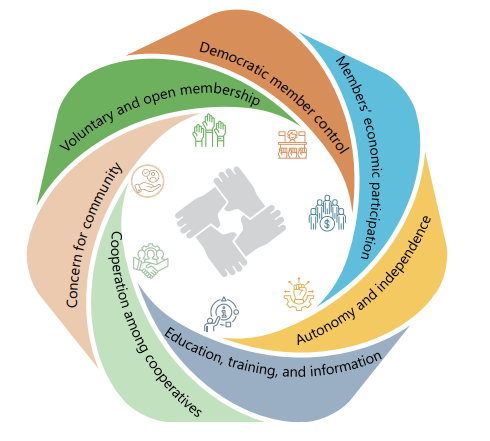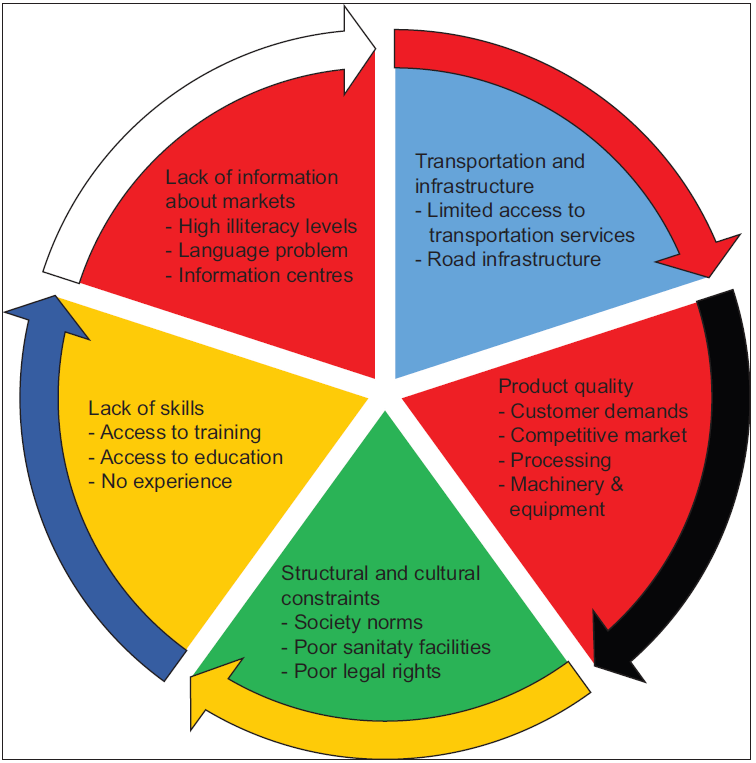Social Issues
Participation of Women in Cooperatives
- 10 May 2025
- 12 min read
For Prelims: United Nations (UN), International Year of Cooperatives, NABARD, Multi-Unit Cooperative Societies Act, 2002, Directive Principle of State Policy, Urban Cooperative Banks, Self-Employed Women's Association (SEWA)
For Mains: Cooperatives in India: Significance of Cooperatives in Women Empowerment, Related Challenges and Way Forward
Why in News?
Despite India being one of the largest cooperative movements in the world, with approximately 8.5 lakh cooperatives, women-only cooperatives still account for only 2.52% of the total, according to a NITI Aayog report (2023).
- The UN has declared 2025 as the International Year of Cooperatives with the theme “Cooperatives Build a Better World,” launching it globally in 2024 India.
What are Cooperative Societies?
- About:
- A cooperative society is a voluntary, member-owned organization designed to meet common economic, social, and cultural needs through self-help, mutual assistance, and community welfare, distinct from profit-driven enterprises.
- Evolution of the Cooperative Movement:
- Pre-Independence Era:
- Informal cooperatives like Chit Funds and Nidhis existed; formalized through the Cooperative Credit Societies Act, 1904 and expanded by the Cooperative Societies Act, 1912 to include marketing and artisan societies.
- Maclagan Committee (1914) recommended a three-tier cooperative banking system, shaping the structural framework for cooperative finance.
- Post-Independence Era:
- Strengthened through Five-Year Plans, establishment of National Cooperative Development Corporation (NCDC) (1963) and NABARD (1982) to boost rural credit and cooperative development.
- Legal and Constitutional Backing:
- Key legislations include Multi-State Cooperative Societies Act (MSCS) (1984 & 2023), National Policy on Cooperatives (2002), and the 97th Constitutional Amendment (2011) granting cooperatives constitutional recognition and protection.
- Recent Developments:
- The Ministry of Cooperation, established in 2021, emphasizes the government’s commitment to enhancing cooperative societies as key contributors to economic progress.
- Pre-Independence Era:
- Types of Cooperatives:
- Consumers' Cooperatives: Provide goods at fair prices by eliminating middlemen (e.g., Kendriya Bhandar).
- Producers' Cooperatives: Support small producers with inputs like raw materials and tools.
- Marketing Cooperatives: Facilitate collective sale of produce to ensure better prices (e.g., Amul).
- Credit Cooperatives: Offer credit and banking services, including rural and urban cooperative banks. (e.g., Urban Cooperative Banks (UCBs)).
- Farming Cooperatives: Promote collective farming benefits for small landholders. (e.g., Primary Agricultural Credit Societies (PACS)).
- Housing Cooperatives: Enable affordable housing through land pooling and shared development (e.g., Employees’ Housing Societies).
- Current Status of Cooperatives in India:
- India’s Position: India accounts for 27% of global cooperatives, with 20% of its population as members, above the global average of 12%.
- Top 3 sectors: Housing (24%), dairy (17.7%), and PACS (13%), accounting for over 54% of all the cooperatives in the country.
- Leading States: Maharashtra (alone accounts for over 25% of the country's cooperatives), Gujarat, Telangana, Madhya Pradesh and Karnataka.
- Principles of Cooperatives:
| Read More: Cooperatives and Their Evolution in India |
What is the Significance of Cooperatives in Women Empowerment?
- Pathway to Socio-Economic Empowerment:
- Cooperatives provide rural women with low-threshold entry into income-generating activities, accessible livelihood options, fair pricing, skill development, and inclusive governance, addressing economic exclusion and enhancing socio-economic resilience.
- Successful models like Self-Employed Women's Association (SEWA) (3.2 million informal women workers), Amul (3.6 million women dairy farmers), and Lijjat Papad (45,000+ home-based producers) illustrate how cooperatives foster both economic self-reliance and social upliftment for women.
- Inclusive Leadership and Historical Recognition:
- Despite significant roles in informal cooperatives like kuries and bhishis in Kerala and Maharashtra, women’s contributions remain under-recognized in formal cooperative narratives.
- Cooperatives can help integrate women into value chains as workers, producers, and decision-makers, thus ensuring equitable benefit-sharing and access to markets.
- Access to Services & Financial Inclusion:
- Women’s cooperatives enhance access to credit, banking, insurance, housing, healthcare, and education, bridging service delivery gaps in underserved areas.
- They also build financial literacy and entrepreneurial capacity, enabling women to manage savings, investments, and small enterprises effectively.
- Social Capital and Community Resilience:
- Cooperatives foster trust, reciprocity, and shared responsibility, helping women build resilience against socio-economic challenges, particularly in rural or disaster-prone areas with limited institutional support.
What are the Key Government Initiatives For Empowering Women Cooperatives?
- Amendment of the MSCS Act, 2023 mandates 2 seats for women on the boards of multi-state cooperatives, ensuring gender equality and decision-making participation.
- Model Bye-Laws for PACS mandates women directors on the boards of over 1 lakh PACS, ensuring women’s representation in grassroots cooperative management.
- NCDC initiatives such as Swayam Shakti Shahakar Yojna provides working capital loans to women SHGs for access to bank credit and Nandini Sahakar offers term loans with interest subvention of up to 2% to women cooperatives for business activities.
- Collaboration Between NABARD, NDDB, and State Governments to focus on enhancing cooperatives in rural areas, including:
- Establishment of Multipurpose PACS, Dairy, and Fishery Cooperatives in Panchayats.
- Cooperation Among Cooperatives pilot project in Gujarat, empowering women in Dairy Cooperatives by designating them as Business Correspondents/Bank Mitras and providing Rupay KCC cards.
What are the Challenges Faced by Women’s Cooperatives in India?
- Structural Constraints:
- Around 50% of women’s cooperatives in India are dormant due to inadequate institutional support, poor financial linkages, lack of training, and limited market access. Most remain small, underfunded, and struggle with sustainability, visibility, and producing market-ready, quality products.
- Time Poverty and Unpaid Labour:
- According to the Time Use Survey (2024), women spend 16.4% of their day on unpaid domestic work, while men spend only 1.7%. This disproportionate burden limits women’s ability to participate in paid or cooperative work.
- Lack of Skills & Underrepresentation:
- Women in rural cooperatives face major challenges due to low literacy, limited education, and lack of skills in business, technology, and marketing. This hampers their participation, leadership, and productivity.
- Poor market access and location in marginalised areas further weaken cooperatives’ viability.
- In mixed cooperatives, women hold only 26% of membership positions, and even fewer leadership roles limiting their influence on decision-making and strategic planning.
- Women in rural cooperatives face major challenges due to low literacy, limited education, and lack of skills in business, technology, and marketing. This hampers their participation, leadership, and productivity.
- Cultural and Social Norms:
- Deep-rooted patriarchy and gendered expectations often curtail women's autonomy, especially in rural areas. Limited mobility, societal scrutiny, and lack of confidence hinder their sustained participation.
What Measures Can be Taken to Empower Women Cooperatives in India?
- Institutional and Financial Support:
- Revive dormant cooperatives through professional guidance, skill-building, and market linkages. Ensure dedicated funding, low-interest credit, and access to equipment.
- Promote cluster-based models tied to value chains, e-commerce, and platforms like GeM for better sustainability and market reach.
- Capacity Building and Training:
- Provide regular training in governance, finance, digital literacy, and marketing, with leadership quotas and mentorship to boost women's participation.
- Recognizing Unpaid Work & Addressing Time Poverty:
- Promote community childcare, shared domestic roles, and time-saving infrastructure to reduce women’s unpaid work.
- Advocating for care services and infrastructure can help women reduce the time spent on unpaid domestic work, thus enabling them to engage more in economic activities like cooperatives.
- Policy Integration and Technological Innovation:
- Policy convergence between the Ministry of Cooperation, Women and Child Development, MSME, and Agriculture is vital to streamline support for women’s cooperatives.
- Promote digital platforms for marketing, training, and financial inclusion, while computerizing PACS and Agricultural and Rural Development Banks (ARDBs) to enhance transparency and efficiency.
Conclusion
Cooperatives can transform the socio-economic landscape for women in India. Empowered women-only cooperatives, with proper resources, training, and leadership, can drive economic and social change. The International Year of Cooperatives in 2025 offers a timely opportunity to reshape policies and empower women at the forefront of this movement.
|
Drishti Mains Question Examine the role of women cooperatives in empowering rural women in India. Discuss the challenges they face and suggest measures to improve their effectiveness. |
UPSC Civil Services Examination, Previous Year Question (PYQ)
Prelims
Q. In India, which of the following have the highest share in the disbursement of credit to agriculture and allied activities? (2011)
(a) Commercial Banks
(b) Cooperative Banks
(c) Regional Rural Banks
(d) Microfinance Institutions
Ans: (a)
Mains
Q. “In the Indian governance system, the role of non-state actors has been only marginal.” Critically examine this statement. (2016)
Q. “In the villages itself no form of credit organisation will be suitable except the cooperative society.” – All India Rural Credit Survey. Discuss this statement in the background of agricultural finance in India. What constraints and challenges do financial institutions supplying agricultural finance face? How can technology be used to better reach and serve rural clients? (2014)








